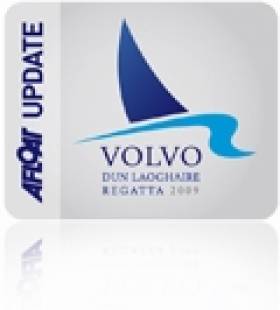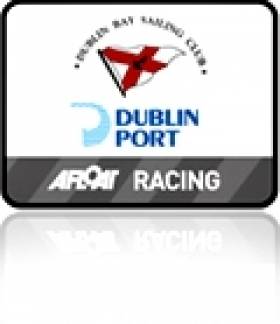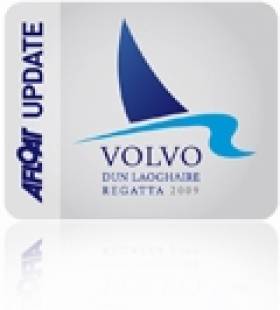Displaying items by tag: Dun Laoghaire
Entries Roll in for Volvo Dun Laoghaire Regatta
Forty entries are already in for Volvo Dun Laoghaire Regatta, a fixture widely expected to be the biggest in Ireland this season when it sets sail on Dublin Bay in July.
Organisers are expecting up to 500 boats to keep it on a par with the 2009 event. The early entries, 11 weeks ahead of the entry deadline, is being taken as a thumbs up by competitors for the fun and vlaue theme of this year's VDLR.
So far 22 different clubs have entered from six countries. The bulk of the fleet is Irish but there are early entries from France, Isle of Man, UK, Wales and Northern Ireland. Another good turnout is exepcted from Liverpool and Holyhead for boats competing in the IRC Lyver Cup Race across the Irish Sea. Ten boats from the Clyde will also compete on the Bay.
Cork's Conor Phelan the skipper of Jump Juice is one of the first Royal Cork boats confirmed.
Two handed IRC racing makes its debut in July's Volvo Dun Laoghaire Regatta organisers have also confirmed. Click HERE.
On the dinghy front, the Fireball class has confirmed it will be running an'Open Championship' within the regatta, an event that follows the class world championships in Sligo in June.
Dun Laoghaire Announces Debut of Two Handed Fleet for Volvo Regatta
Two handed IRC racing makes its debut in July's Volvo Dun Laoghaire Regatta organisers have confirmed this week. Up to six boats have expressed interest in the new intiative and the organisers say the class will race over a mix of coastal and windward leeward courses. It's an exciting development for the regatta that is already receiving a flow of entries 11 weeks ahead of the entry deadline.
Double handed Class captain Olivier Prouveur of the National YC says boats that have expressed an interest so far are the regular ISORA participant Mojito from the UK, Team Windmill (J109), JBellino (J-122), Dinah (Barry Hurley's modified JOD 35 with which he won his class in the OSTAR 2009) and Oystercatcher (second in the two-handed class in the Round Ireland race).
Other boats are also likely now that the regatta has confirmed the class start, according to Prouveur. The hope of course is others, such as round Ireland winners Psipina Paddy Cronin and John Loden or Alchemiste Michael Murphy and Alex Voye might also be interested.
Rejig Means No South Coast Match Racing Fixtures
There will be no match racing on the south coast this year following a rejig of the fixtures calendar.
After two years of expansion for match racing in terms of events the theme for 2011 is consolidation.
Changes to the ISA SailFleet schedule for the boats mean that we have had to go through a rejigging of the match racing calendar.
The major impact is that Royal Cork YC are to take the boats latter than originally hoped meaning that they will be unable to host a leg of the Tour.
With Kinsale not taking part in the SailFleet scheme this year that means no match racing on the south coast for the first time in a couple of years.
With no tie up with the Dun Laoghaire Festival of Cultures available this year a date of July 23rd and 24th has been settled on for the Ireland vs The World International.
The highlight of last year this event will once again pit Irelands 6 best match racers against 6 teams from the rest of the world. Once again National and Tour champion John Sheehy will captain the Irish team.
The Leinster Match Racing Open, to be hosted by the Royal Irish Yacht Club, has been moved to July 16th and 17th to allow it to act as qualification for the Irish team for the following weekend and to give Laura Dillion and the Gladiators (Sam Hunt, Paddy Blackley, Peter Bayly, Richard Murphy) competitive practice immediately before heading over to Poland to represent the country at the ISAF Nations Cup.
Howth Yacht Club's, Dublin Match Racing Open stays with a date of September 3rd and 4th before we head for Lough Derg and the Womens (October 15th and 16th) and Open National Championships (November 5th And 6th).
All of the above means that here will be no Munster Match Racing Open this year and work continues to find a host for the IUSA Student Match Racing Nationals with Galway a potential for early April. There has been considerable work on the cost of entry for events over the winter and the majority of events will have a basic entry of €330 this year. All events will be run at ISAF grade 3.
Revised calendar
July 16-17th – Leinster Match Racing Open, Royal Irish Yacht Club
July 23-24th – Ireland vs The World International, Royal St George Yacht Club
September 3rd and 4th – Dublin Match Racing Open, Howth Yacht Club
October 15th and 16th - Womens Match Racing Championships, Lough Derg Yacht Club
November 5th and 6th – National Match Racing Championships, Lough Derg Yacht Club
Lecture: "Captain Halpin of the Great Eastern"
Green Party Speaks Out for Small Boat Owners in Dun Laoghaire
Ciaran Cuffe TD of the Green Party has spoken out in support of small boat owners in a submission to the Dún Laoghaire Harbour Masterplan. Cuffe, a candidate in the General Election, says the prioritisation of space within the harbour for surface car parking and marshalling yards for ferry services has reduced the space available for small boat owners. Cuffe says the masterplan should specifically enhance facilities and storage space for small boat owners, such as the Coal Harbour Users Group (CHUG) and local yacht and water sports clubs. He also says consideration should be given to the development of workshops to promote traditional boat building and small craftrepair and restoration.
The full submission from Ciaran Cuffe is below:
"I welcome the preparation by the Dún Laoghaire Harbour of a masterplan for the harbour area. Dún Laoghaire harbour is a major recreational and amenity resource for the locality andwider Dún Laoghaire area and a long-term strategic vision underpinned by a plan-ledimplementation framework is vital in order to secure the harbour's future for the benefit of both the Harbour Company and the local community.
Maintaining a ferry link to the UK
I welcome the proposal to redefine Dún Laoghaire Harbour as a leisure harbour. However, Ibelieve that future opportunities to keep a ferry link with the UK should not be lost. As we have seen during recent incidents when airplanes were grounded, travelling by ferry is still aviable means of travel and may become increasingly so in the future. A seasonally ferryduring the summer months could be considered and the infrastructure needed for a ferryservice should be maintained. The Harbour Company should work to secure INTERREG funding to provide better linked-in ferry and train services between Ireland and the UK.
Cruise Ships & Tourist Development
There is considerable scope to attract the cruise liner market to Dún Laoghaire. Dún Laoghaire is a fantastic harbour location with a unique built and natural heritage. Its location immediately adjacent to the Dún Laoghaire DART station makes it an ideal gateway locationfor tourists to explore Dublin City and hinterland. We have seen the positive impact of large cruise liners docking at Dublin Port with thousands of visitors disembarking, visiting Dublin's tourist attractions and spending money in local businesses. Dún Laoghaire Harbours offers a much more pleasant and suitable docking location for cruiseships and there is a major opportunity to exploit this economic potential for the benefit of the wider locality. Any physical works required to facilitate the mooring of large cruise liners in Dún Laoghaire should be carefully designed so as to avoid any adverse impact on local builtand natural heritage, including the Dublin Bay Special Area of Conservation.
Built Heritage
The unique physical fabric and built heritage Dún Laoghaire Harbour is an important assetand must be conserved and enhanced. In particular, the historic Carlisle Pier now has thepotential to provide a high quality outdoor public amenity space. I understand that elements of the 1890's Victorian railway building have been retained and I believe that these elements should be reconstituted as part of multi-functional covered space to, for example, host an ice-rink in winter, the Festival of World Cultures in summer and occasional outdoor events andmarkets.
Open Space & Public Accessibility
In recent years significant areas of the Harbour Company land was converted to revenuegenerating surface car parking. This has created a car dominated environment and adisconnect between the harbour area and Dún Laoghaire town. The long-term future of theharbour is much better served by opening up the harbour area to pedestrians and cyclists, enhancing accessibility for the general public, improve directional signage, reducing surfacecar parking and delivering more green spaces. In order to achieve this, the Masterplan shouldinclude a detailed design framework for the public realm including further measures to removethe barriers to accessibility due to the rail line.
Views
The sensitive built, natural and visual environment of the harbour requires a very carefulapproach to any future infill development. Particularly, infill development should be in keepingwith the existing building heights of the town to protect the harbour setting and views fromDún Laoghaire to Dublin Bay and Howth Head and sensitively designed to conserve thecharacter of local built heritage and the numerous important protected structures.
Small Boat Owners
The prioritisation of space within the harbour for surface car parking and marshalling yards for ferry services has reduced the space available for small boat owners. The masterplan should specifically enhance facilities and storage space for small boat owners, such as the CoalHarbour Users Group (CHUG) and local yacht and water sports clubs. Consideration should be given to the development of workshops to promote traditional boat building and small craftrepair and restoration.
Conclusion
Dún Laoghaire is extremely fortunate to have a unique historic harbour resource, which is a central part of the local identity and a much loved and valued social, recreational, and amenity resource. However, the future economic viability of the harbour is dependent on creating appropriate synergies with the wider economy of Dún Laoghaire. The imaginative redevelopment of the harbour can contribute significantly to the local economy, particularly inthe development of heritage and tourism initiatives, The Masterplan must focus on how the future development of the harbour can contribute to cultivating these synergies in a manner, which is economically, socially and environmentally sustainable."
Light Start to DBSC Spring Chicken Series
The first Dublin Bay Sailing Club race of the Viking Marine Spring Chicken series got away to a nice start, although a bit light for most last Sunday. This weekend's race looks like there could be a little bit more in the way of breeze!
Attached below are the sailing results from the first race, handicaps and Starts for next Sunday.
Maritime Museum Needs You!
The Maritime Institute of Ireland (M.I.I.) is looking for volunteers to assist in the running of the maritime museum, located in the former Mariners' Church in Dun Laoghaire, Co. Dublin.
A Volunteers Induction Meeting is to be held on 15 February at 8 p.m. in the Dun Laoghaire Club. Please register in advance. For further details click this link.
In addition to the various roles and activities required in the operation of the museum, the institute, are looking for people who can assist from time to time with the setting up of special exhibitions, the making of DVDS to go with displays and website maintenance.
For general information and other updates about the museum log on to www.mariner.ie
Ten Days of Racing on the South Coast
The ICRA National Championships is being staged at Royal Cork YC from Friday 17th to Sunday 19th June and the Sovereign's Cup at Kinsale YC from Wednesday 22nd to Saturday 25th June.
Dublin boats heading south for these events can race down to the event as part of the Dun Laoghaire to Dingle Race (it's the tenth anniversary race) from the National Yacht Club starting on Saturday, June 11th next.
Entry form for ICRA and Notice of Race available to download below.
First entries in for Volvo Dun Laoghaire Regatta
July's Volvo Dun Laoghaire regatta has taken in 22 entries six months ahead of the first race. It's an encouraging figure that's on a par with the 2009 VDLR, the biggest regatta in Irish sailing that year.
The positive early response is an indication, says organiser Adam Winkelmann, that the 2011 fleet, should be a bumper one too when it sets sail on July 7th for the four day event.
The emphasis is again on providing quality racing over different courses each day but organisers are also aiming to live up up to the regatta's pre-event billing as a 'Mega Party'.
The event has opened a new website, a new Facebook page (with afloat.ie, so if you're a Facebook user please show your support and 'like it'). The regatta site is also featuring the youtube clip below of events on the bay two years ago.
So far entries received are spread across nine separate classes but it's a visiting Wayfarer fleet with eight boats named already that is setting the pace. The organisers are expecting up to 50 of the two man classic design for the class National Championships that's being staged as part of the regatta.
The notice of race (NOR) was published online in October and highlighted a reduced entry fee for 'earlybird entries'. Click HERE. or scroll down to download it as a PDF. If you participated in 2009 and entered online, this year you only need to enter your email address.
Three boats are entered in the non spinnaker class and another three in the Squib keelboat. Two entries have been received in both IRC 2 and 3.
It's still too early for a table of bands to be decided but the organisers intend to give some indication of handicap break-ups as the entries build. The IRC bands will be in line with those laid down by the Irish Cruiser Racing Association.
Despite the fact the regatta's strength since 2007 is that it draws on the capital's own fleet of 400 boats it is in fact visitors from elsewhere on the east coast that are first in. East Down Yacht Club, for example, has four entries.
But locals are signing up too. Single entries have been received in the Mermaid, Beneteau 31.7, Dragon and IRC Zero classes.
Course areas are likely to stay the same according to principal Race officer con Muphy of the National YC. Th race team is Alan Crosbie - KYC, Peter Crowley - RCYC,
David Lovegrove - HYC, Harry Gallagher - HYC, Henry Leonard - RIYC, Jack Roy - RIYC and Con Murphy - NYC. Mike Butterfield will head up the jury.
The organisers are on the look out for volunteers to assist in the run up to and during the country's biggest sailing event. In 2009 over 300 helped to make it the biggest participant sport event in the country after the city marathon, with over 3,500 sailors afloat. More details from Ciara in the event office HERE.
Plans For Pontoon Berth Despite Block on Carlisle Pier Development
The Dun Laoghaire Harbour company has issued an invitation to tender for a new floating berth, despite being refused permission to continue development of the historic Carlisle Pier, The Sunday Business Post reports.
Most of the listed structure was torn down in September 2009 and replaced with a car park by the company, which said it received legal advice that planning permission was not required.
Following a campaign by local residents and the intervention of Green Party TD Ciarán Cuffe and Dun Laoughaire Rathdown County Council, An Bord Pleanála ruled that the redevelopment was not exempted.
According to The Sunday Tribune, the development plans were rejected on the basis of their effect on the local conservation area and failure to reuse elements of the old pier structures.
However, last week the company published a notice inviting tenders for a floating pontoon berth to be attached to the old pier, designed to accommodate cruise passengers.
The tender details are available to read online, and the project is currently pending planning permission.
The harbour company is part of the Dun Laoghaire Cruise Stakeholder Group, which is marketing the town as a destination for international cruise liners.






































































